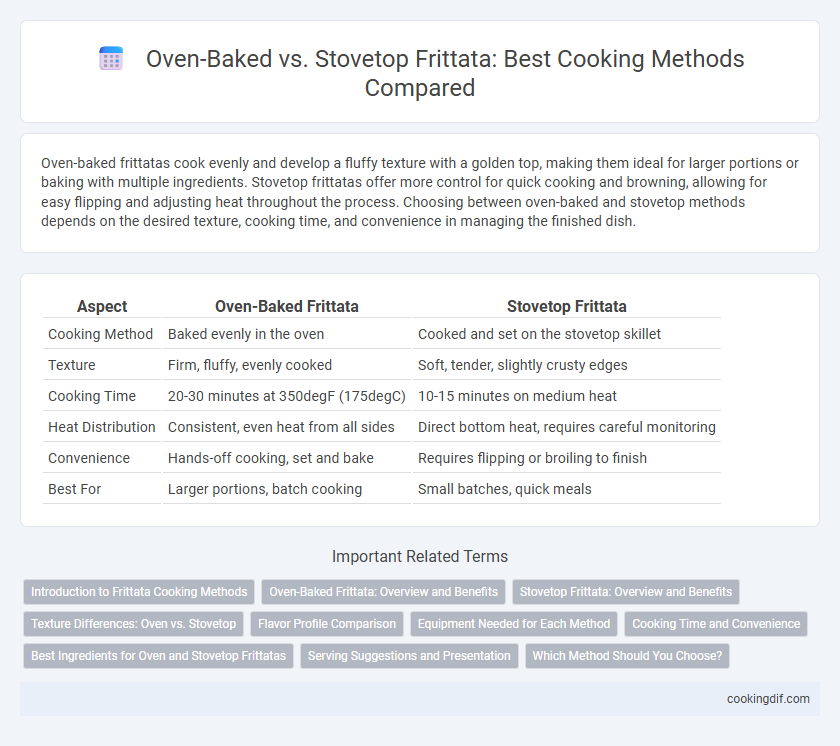Oven-baked frittatas cook evenly and develop a fluffy texture with a golden top, making them ideal for larger portions or baking with multiple ingredients. Stovetop frittatas offer more control for quick cooking and browning, allowing for easy flipping and adjusting heat throughout the process. Choosing between oven-baked and stovetop methods depends on the desired texture, cooking time, and convenience in managing the finished dish.
Table of Comparison
| Aspect | Oven-Baked Frittata | Stovetop Frittata |
|---|---|---|
| Cooking Method | Baked evenly in the oven | Cooked and set on the stovetop skillet |
| Texture | Firm, fluffy, evenly cooked | Soft, tender, slightly crusty edges |
| Cooking Time | 20-30 minutes at 350degF (175degC) | 10-15 minutes on medium heat |
| Heat Distribution | Consistent, even heat from all sides | Direct bottom heat, requires careful monitoring |
| Convenience | Hands-off cooking, set and bake | Requires flipping or broiling to finish |
| Best For | Larger portions, batch cooking | Small batches, quick meals |
Introduction to Frittata Cooking Methods
Oven-baked frittatas offer even heat distribution that ensures a uniformly cooked texture and a golden, slightly crisp top, ideal for larger, thicker mixtures with multiple ingredients. Stovetop frittatas allow more control over cooking speed and provide a softer, creamier interior, making them suitable for smaller portions and quick preparation. Choosing between oven and stovetop depends on desired texture, ingredient complexity, and cooking convenience.
Oven-Baked Frittata: Overview and Benefits
Oven-baked frittatas offer even heat distribution, ensuring consistent cooking and a tender, custard-like texture throughout. The slow, indirect heat preserves moisture and allows for a perfectly set center without overcooking the edges. Baking also enables easy incorporation of diverse ingredients like vegetables, cheese, and meats, creating a versatile and visually appealing dish.
Stovetop Frittata: Overview and Benefits
Stovetop frittatas cook evenly over medium heat, allowing for precise control of temperature and preventing overcooking. This method enhances the texture, producing a creamy interior and a slightly crisp, golden bottom. Stovetop cooking also enables quick monitoring and adjustments, ideal for small batches and flexible ingredient additions.
Texture Differences: Oven vs. Stovetop
Oven-baked frittatas develop a uniformly firm and fluffy texture with a golden, slightly crispy top due to even heat distribution. Stovetop frittatas tend to have a creamier interior with a softer, less browned surface since direct heat can cause uneven cooking. The choice between methods affects moisture retention and overall mouthfeel, making oven-baking ideal for a more set structure while stovetop offers a tender, custard-like consistency.
Flavor Profile Comparison
Oven-baked frittatas develop a rich, evenly cooked flavor with a slightly caramelized crust that enhances the natural sweetness of the ingredients. Stovetop frittatas often have a creamier texture and a more pronounced egg flavor due to direct heat and frequent stirring. The choice between methods influences the balance of textures and intensities, with oven baking promoting depth and stovetop emphasizing freshness.
Equipment Needed for Each Method
Oven-baked frittatas require a baking dish or an oven-safe skillet, along with an oven preheated to around 350degF (175degC). Stovetop frittatas need a non-stick skillet or cast-iron pan with a lid to help cook the eggs evenly on low heat. Both methods benefit from using a spatula for gentle folding and serving, but the stovetop method demands more frequent monitoring to prevent burning.
Cooking Time and Convenience
Oven-baked frittatas typically require 20-25 minutes at 350degF, offering hands-free cooking and even heat distribution, ideal for batch preparation. Stovetop cooking completes in 10-15 minutes with direct control over heat but demands constant attention and frequent flipping to prevent burning. Oven-baking provides convenience for multitasking, whereas stovetop methods deliver faster results but require more active involvement.
Best Ingredients for Oven and Stovetop Frittatas
Oven-baked frittatas benefit from ingredients that hold their shape and texture well under prolonged cooking, such as dense vegetables like potatoes, bell peppers, and spinach, combined with firmer cheeses like feta or aged cheddar. Stovetop frittatas work best with ingredients that cook quickly and release moisture evenly, including fresh herbs, mushrooms, tomatoes, and softer cheeses like mozzarella or goat cheese. Using high-quality eggs and seasoning like sea salt and cracked black pepper enhances flavor profiles regardless of the cooking method.
Serving Suggestions and Presentation
Oven-baked frittatas offer a uniform, golden-brown finish that enhances visual appeal, making them ideal for slicing into neat wedges served on elegant platters with fresh herbs and vibrant salads. Stovetop frittatas, with their slightly rustic texture and tender, creamy center, are best presented directly from the pan, offering a more casual, homey feel ideal for hearty brunches or family meals. Both methods pair beautifully with complementary sides like crusty bread, roasted vegetables, or tangy sauces to elevate the overall dining experience.
Which Method Should You Choose?
Oven-baked frittatas offer even heat distribution, resulting in a uniformly cooked, fluffy texture ideal for larger portions or when adding multiple ingredients. Stovetop frittatas cook faster and allow for easy monitoring but may require careful flipping to avoid uneven cooking or burning. Choosing between oven-baked and stovetop methods depends on desired texture, portion size, and cooking convenience.
Oven-baked vs Stovetop for frittata cooking Infographic

 cookingdif.com
cookingdif.com